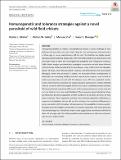Files in this item
Immunogenetic and tolerance strategies against a novel parasitoid of wild field crickets
Item metadata
| dc.contributor.author | Sikkink, Kristin L. | |
| dc.contributor.author | Bailey, Nathan W. | |
| dc.contributor.author | Zuk, Marlene | |
| dc.contributor.author | Balenger, Susan L. | |
| dc.date.accessioned | 2020-10-30T12:30:15Z | |
| dc.date.available | 2020-10-30T12:30:15Z | |
| dc.date.issued | 2020-10-26 | |
| dc.identifier | 270956468 | |
| dc.identifier | 1ed2da99-0b19-4e97-b3ee-da3c4a94024f | |
| dc.identifier | 85093917269 | |
| dc.identifier | 000583622500001 | |
| dc.identifier.citation | Sikkink , K L , Bailey , N W , Zuk , M & Balenger , S L 2020 , ' Immunogenetic and tolerance strategies against a novel parasitoid of wild field crickets ' , Ecology and Evolution , vol. Early view . https://doi.org/10.1002/ece3.6930 | en |
| dc.identifier.issn | 2045-7758 | |
| dc.identifier.other | RIS: urn:371C6F0C37AA14A59FF0DA4BCB10D595 | |
| dc.identifier.other | ORCID: /0000-0003-3531-7756/work/82788901 | |
| dc.identifier.uri | https://hdl.handle.net/10023/20863 | |
| dc.description.abstract | Among the parasites of insects, endoparasitoids impose a costly challenge to host defenses because they use their host?s body for the development and maturation of their eggs or larvae, and ultimately kill the host. Tachinid flies are highly specialized acoustically orienting parasitoids, with first instar mobile larvae that burrow into the host's body to feed. We investigated the possibility that Teleogryllus oceanicus field crickets employ postinfestation strategies to maximize survival when infested with the larvae of the parasitoid fly Ormia ochracea. Using crickets from the Hawaiian Islands of Kauai, where the parasitoid is present, and crickets from the Cook Islands (Mangaia), where the parasitoid is absent, we evaluated fitness consequences of infestation by comparing feeding behavior, reproductive capacity, and survival of males experimentally infested with O. ochracea larvae. We also evaluated mechanisms underlying host responses by comparing gene expression in crickets infested with fly larvae for different lengths of time with that of uninfested control crickets. We observed weak population differences in fitness (spermatophore production) and survival (total survival time postinfestation). These responses generally did not show an interaction between population and the number of larva hosts carried or by host body condition. Gene expression patterns also revealed population differences in response to infestation, but we did not find evidence for consistent differences in genes associated with immunity or stress response. One possibility is that any postinfestation evolved resistance does not involve genes associated with these particular functional categories. More likely, these results suggest that coevolution with the fly does not strongly select for either postinfestation resistance or tolerance of parasitoid larvae in male crickets. | |
| dc.format.extent | 15 | |
| dc.format.extent | 1768680 | |
| dc.language.iso | eng | |
| dc.relation.ispartof | Ecology and Evolution | en |
| dc.subject | Ormia ochracea | en |
| dc.subject | Resistance | en |
| dc.subject | Teleogryllus oceanicus | en |
| dc.subject | Transcriptomics | en |
| dc.subject | QH301 Biology | en |
| dc.subject | QR180 Immunology | en |
| dc.subject | DAS | en |
| dc.subject.lcc | QH301 | en |
| dc.subject.lcc | QR180 | en |
| dc.title | Immunogenetic and tolerance strategies against a novel parasitoid of wild field crickets | en |
| dc.type | Journal article | en |
| dc.contributor.institution | University of St Andrews. School of Biology | en |
| dc.contributor.institution | University of St Andrews. Centre for Biological Diversity | en |
| dc.identifier.doi | https://doi.org/10.1002/ece3.6930 | |
| dc.description.status | Peer reviewed | en |
This item appears in the following Collection(s)
Items in the St Andrews Research Repository are protected by copyright, with all rights reserved, unless otherwise indicated.

